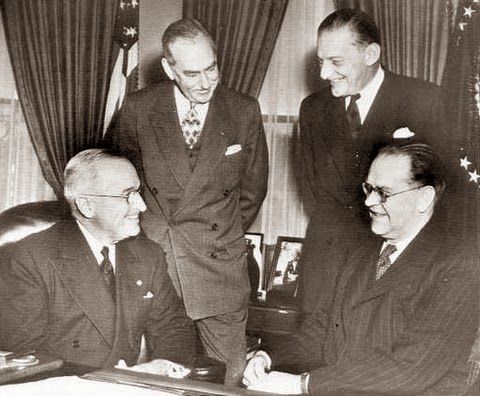U.S. President Harry Truman sitting next
to Swedish Prime Minister (for 23 years)
Tage Erlander, with U.S.
Secretary of State Dean Acheson (left)
and Erik Boheman: Sweden's Jewish
ambassador to the U.S.
On June 25, 1997, Swedish academic and
diplomat Professor Krister Wahlbäck told the
U.S. Congressional House Committee on
Banking on Financial Services (convened
to discuss gold and assets looted by the
Nazis):
"His (Erik Boheman: 1895
- 1975) perspective is
interesting not least
because his family
background made him acutely
aware of the values at stake
in Word War II. His mother
was Jewish, and his sister
was married into the
Josephson family, perhaps
our foremost Jewish family
in the field of arts and
culture."
On January 8, 1940, William
Montagu-Pollock the British
Ambassador in Sweden wrote to
Laurence Collier head of the
Northern Department of the Foreign
Office advising him of some tall
tales he'd been told that day by
Sweden's Jewish State Secretary for
Foreign Affairs Erik Boheman:
"Boheman told me to-day
that the Swedish Government
had sent a Secretary back to
Warsaw but that the Germans
had only allowed him to stay
there for there weeks. The
Germans were now insisting
that even the Swedish Consul
at Warsaw should leave.
Boheman mentioned that
when the Secretary was out
in the country one day he
came upon a turnip cutter
normally worked by a pair of
horses walking in circles.
Attached to the cutter was a
gang of elderly Jews with a
Nazi urging them on with a
whip. At intervals they were
told to stop and eat grass,
which they promptly did. Boheman
also said that the entire
faculty of the University of
Cracow had been summoned to
attend a lecture and when
they arrived they were
herded together and driven
off to a concentration camp.
I am sending a copy of
this pretty story to
Wiskeman."
UK National Archives: FO 371/24469
pp.
8-9: Pollock to Collier, 08.01.1940,
C618.
I know of this story thanks to British
historian David G. Williamson's 2009
book Poland Betrayed:
The Nazi-Soviet Invasions of 1939,
whose source I photographed at the
National Archives. Williamson not only managed to
muddle-up the chain of storytellers,
claiming the British diplomat had been
told the story by a Swedish diplomat who
had witnessed the scene with his own
eyes. Williamson also neglected to tell
his readers that the story was quite
clearly disbelieved by the Brit
(Montagu-Pollock) whose sarcastically
worded letter is his source.



































